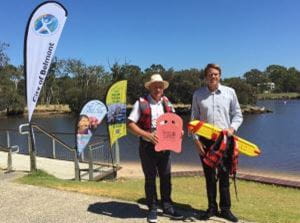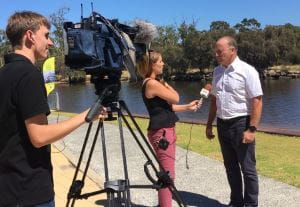Teaching at risk youth to be safe in our inland waterways
Australia’s inland waterways continue to be the leading location for fatal drowning, accounting for 97 deaths in 2016/17, almost one third of the nation’s total drowning toll. This included 68 at rivers and creeks, and 29 at lakes and dams.
In Western Australia, there was a 23% increase in the number of deaths occurring at inland waterways compared to the previous year, with the majority occurring at rivers, creeks and streams in regional and remote areas of the state.
 People visiting from overseas are also at a greater risk of drowning with 20 overseas tourists drowning in Australia last year, predominately from European (45%) and Asian (40%) countries, as well as six international students. Royal Life Saving Society WA Senior Manager Swimming and Water Safety Education Trent Hotchkin says “Those coming to Australia from overseas - whether as tourists or migrants - are at a far higher risk of drowning than the rest of the population, largely due to a lack of access to waterways for recreation in their homeland, and a lower emphasis on swimming and water safety education in these nations.”
People visiting from overseas are also at a greater risk of drowning with 20 overseas tourists drowning in Australia last year, predominately from European (45%) and Asian (40%) countries, as well as six international students. Royal Life Saving Society WA Senior Manager Swimming and Water Safety Education Trent Hotchkin says “Those coming to Australia from overseas - whether as tourists or migrants - are at a far higher risk of drowning than the rest of the population, largely due to a lack of access to waterways for recreation in their homeland, and a lower emphasis on swimming and water safety education in these nations.”
Recent drowning data shows that 34.3% of drowning deaths in WA involved people who were born overseas, and this proportion has increased significantly over the past few years. Mr Hotchkin says this is a real concern “In the past 12 months two young men from culturally and linguistically diverse backgrounds have drowned at Perth’s Blackwall Reach which is a stark reminder of the risks associated with participating in activities at these locations. Our rivers are beautiful and attract many people to recreate in and around them, but more people drown in rivers than anywhere else with the Swan River ranked as the fourth highest drowning blackspot in Australia. The dangers are often lurking below the surface, you simply can’t see rocks, snags like tree branches or strong currents, but they can be lethal.”
“It is important that everyone has the necessary skills to participate safely at all aquatic locations, particularly inland waterways. This summer Royal Life Saving is focussed on ensuring young people from at-risk communities and culturally and linguistically diverse backgrounds learn these vital skills.”
This week Royal Life Saving has held a school holiday Swim and Survive on the Swan program for multicultural young people at Ascot Kayak Club. The aim of the program, supported by the City of Belmont’s Community Contribution Fund, was to raise awareness of the potential dangers present in the river environment, and teach children essential swimming and lifesaving skills via our Bronze Medallion program. 15 participants joined the program from a variety of cultural backgrounds including Burmese, Indian and Afghani. They thoroughly enjoyed learning swimming, survival and rescue skills from instructors Liz Fowler and Mel Ko.
Federal Member for Swan, Steve Irons is supportive of the program, “The electorate of Swan is bordered by the river and residents and visitors to the area spend much of their time around it. With the warmer months upon us it is important that children learn essential swimming and lifesaving skills to ensure that safety is their number one priority. The City of Belmont has a large multicultural community and Mr Irons says this makes the multicultural focus of this program especially important. “It’s of critical importance that everyone in our diverse community is familiar with water safety so they have the confidence to enjoy swimming over summer.”
Royal Life Saving WA encourages all West Australians to stay safe in our inland waterways over the summer months. Senior Manager Swimming and Water Safety Education Trent Hotchkin says “We are asking people to follow four simple steps to reduce their drowning risk in rivers: wear a lifejacket, avoid alcohol around water, never swim alone and learn how to save a life.”
Swim and Survive on the Swan is part of Royal Life Saving’s Respect The River program, which is funded by the Federal Government and aims to raise awareness of the many hazards that underlie our rivers, lakes and streams.
You can learn more about Respect the River at the link below.
